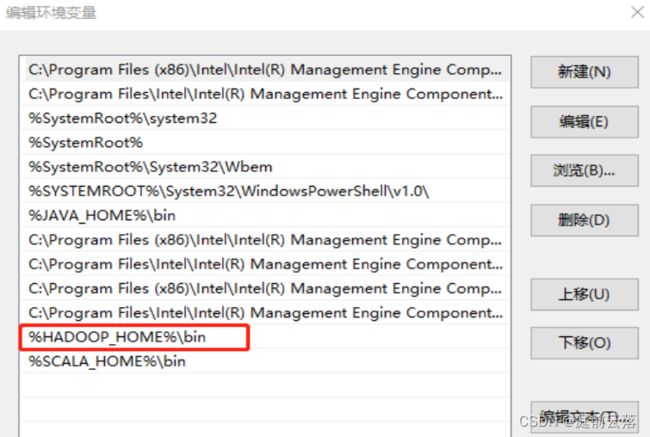从零开始的Hadoop学习(五)| HDFS概述、shell操作、API操作
1. HDFS 概述
1.1 HDFS 产出背景及定义
1)HDFS 产生背景
随着数据量越来越大,在一个操作系统存不下所有的数据,那么就分配到更多的操作系统管理的磁盘中,但是不方便管理和维护,迫切 需要一种系统来管理多台机器上的文件,这就是分布式文件管理系统。 HDFS只是分布式文件管理系统中的一种。
2)HDFS定义
HDFS(Hadoop Distributed File System),它是一个文件系统,用于存储文件,通过目录树来定位文件: 其次,它是分布式的,由很多服务器联合起来实现其功能,集群中的服务器有各自的角色。
HDFS 的使用场景:适合一次写入,多次读出的场景。 一个文件经过创建写入和关闭之后就不需要改变。
1.2 HDFS 优缺点
HDFS优点
1)高容错性
- 数据自动保存多个副本。它通过增加副本的形式,提高容错性。
- 某一个副本丢失以后,它可以自动恢复。
2)适合处理大数据
- 数据规模:能够处理数据规模达到GB、TB、甚至BP级别的数据;
- 文件规模:能够处理百万规模以上的文件数量,数量相当之大。
3)可构建在廉价机器上,通过多副本机制,提高可靠性。
HDFS缺点
1)不适合低延时数据访问,比如毫秒级的存储数据,是做不到的。
2)无法高效的对大量小文件进行存储。
- 存储大量小文件的话,它会占用NameNode大量的内存来存储文件目录和块信息。这样是不可取的,因为NameNode的内存总是有限的;
- 小文件存储的寻址时间会超过读取时间,它违反了 HDFS 的设计目标。
3)不支持并发写入,文件随机修改。
- 一个文件只能有一个写,不允许多个线程同时写。
- 仅支持append(追加),不支持文件的随机修改。
1.3 HDFS 组成架构
1)NameNode(nn):就是Master,它是一个主管、管理者。
- (1)管理HDFS的名称空间;
- (2)配置副本策略;
- (3)管理数据块(Block)隐射信息;
- (4)处理客户端读写请求。
2)DataNode:就是Slave。NameNode下达命令,DataNode执行实际的操作。
- (1)存储实际的数据块;
- (2)执行数据块的读/写操作。
3)Client:就是客户端。
- (1)文件切分。文件上传HDFS的时候,Clinet将文件切分成一个一个的Block,然后进行上传;
- (2)与NameNode交互,获取文件的位置信息;
- (3)与DataNode交互,读取或者写入数据;
- (4)Client提供一些命令来管理HDFS,不如NameNode格式化;
- (5)Client可以通过一些命令来访问HDFS,比如对HDFS增删改操作;
4)Secondary NameNode:并非NameNode的热备。当NameNode挂掉的时候,它并不能马上替换NameNode并提供服务。
- (1)辅助NameNode,分组其工作量,比如定期合并Fsimage和Edits,并推送给NameNode;
- (2)在紧急情况下,可辅助恢复NameNode。
1.4 HDFS 文件块大小(面试重点)
HDFS中的文件在物理上是分块存储(Block),块的大小可以通过配置参数(dis.blocksize)来规定, 默认大小在Hadoop2.x/3.x版本中是128M,1.x版本中是64M。

思考:为什么块的大小不能设置太小,也不能设置太大?
- (1)HDFS的块设置太小,会增加寻址时间,程序一直在找块的开始位置;
- (2)如果块设置的太大,从磁盘传输数据的时间会明显大雨定位这个块开始位置所需的时间。导致程序在处理这块数据时,会非常慢。
总结:HDFS块的大小设置主要取决于磁盘传输速度。
2. HDFS的shell操作(开发重点)
2.1 基本语法
hadoop fs 具体命令 OR hdfs dfs具体命令。
2.2 命令大全
[atguigu@hadoop102 hadoop-3.1.3]$ bin/hadoop fs
[-appendToFile <localsrc> ... <dst>]
[-cat [-ignoreCrc] <src> ...]
[-chgrp [-R] GROUP PATH...]
[-chmod [-R] <MODE[,MODE]... | OCTALMODE> PATH...]
[-chown [-R] [OWNER][:[GROUP]] PATH...]
[-copyFromLocal [-f] [-p] <localsrc> ... <dst>]
[-copyToLocal [-p] [-ignoreCrc] [-crc] <src> ... <localdst>]
[-count [-q] <path> ...]
[-cp [-f] [-p] <src> ... <dst>]
[-df [-h] [<path> ...]]
[-du [-s] [-h] <path> ...]
[-get [-p] [-ignoreCrc] [-crc] <src> ... <localdst>]
[-getmerge [-nl] <src> <localdst>]
[-help [cmd ...]]
[-ls [-d] [-h] [-R] [<path> ...]]
[-mkdir [-p] <path> ...]
[-moveFromLocal <localsrc> ... <dst>]
[-moveToLocal <src> <localdst>]
[-mv <src> ... <dst>]
[-put [-f] [-p] <localsrc> ... <dst>]
[-rm [-f] [-r|-R] [-skipTrash] <src> ...]
[-rmdir [--ignore-fail-on-non-empty] <dir> ...]
<acl_spec> <path>]]
[-setrep [-R] [-w] <rep> <path> ...]
[-stat [format] <path> ...]
[-tail [-f] <file>]
[-test -[defsz] <path>]
[-text [-ignoreCrc] <src> ...]
2.3 常用命令实操
2.3.1 准备工作
1)启动 Hadoop 集群(方便后续的测试)
[atguigu@hadoop102 hadoop-3.1.3]$ sbin/start-dfs.sh
[atguigu@hadoop103 hadoop-3.1.3]$ sbin/start-yarn.sh
2)-help:输出这个命令参数
[atguigu@hadoop102 hadoop-3.1.3]$ hadoop fs -help rm
3)创建/sanguo 文件夹
[atguigu@hadoop102 hadoop-3.1.3]$ hadoop fs -mkdir /sanguo
2.3.2 上传
1)-moveFromLocal:从本地剪切粘贴到 HDFS
[atguigu@hadoop102 hadoop-3.1.3]$ vim shuguo.txt
输入:
shuguo
[atguigu@hadoop102 hadoop-3.1.3]$ hadoop fs -moveFromLocal ./shuguo.txt /sanguo
2)-copyFormLocal:从本地文件系统中拷贝文件到 HDFS 路径去
[atguigu@hadoop102 hadoop-3.1.3]$ vim weiguo.txt
输入:
weiguo
[atguigu@hadoop102 hadoop-3.1.3]$ hadoop fs -copyFromLocal weiguo.txt /sanguo
3)-put:等同于 copyFromLocal,生产环境更习惯用 put
[atguigu@hadoop102 hadoop-3.1.3]$ vim wuguo.txt
输入:
wuguo
[atguigu@hadoop102 hadoop-3.1.3]$ hadoop fs -put ./wuguo.txt /sanguo
4)-appendToFile:追加一个文件到已经存在的文件末尾
[atguigu@hadoop102 hadoop-3.1.3]$ vim liubei.txt
输入:
liubei
[atguigu@hadoop102 hadoop-3.1.3]$ hadoop fs -appendToFile liubei.txt /sanguo/shuguo.txt
2.3.3 下载
1)-copyToLocal:从HDFS 拷贝到本地
[atguigu@hadoop102 hadoop-3.1.3]$ hadoop fs -copyToLocal /sanguo/shuguo.txt ./
2)-get:等同于 copyToLocal,生产环境更习惯用 get
[atguigu@hadoop102 hadoop-3.1.3]$ hadoop fs -get /sanguo/shuguo.txt ./shuguo2.txt
2.3.4 HDFS 直接操作
1)-ls:现实目录信息
[atguigu@hadoop102 hadoop-3.1.3]$ hadoop fs -ls /sanguo
2)-cat:显示文件内容
[atguigu@hadoop102 hadoop-3.1.3]$ hadoop fs -cat /sanguo/shuguo.txt
3)-chgrp、-chmod、-chown:Linux 文件系统中的用法一样,修改文件所属权限
4)-mkdir:创建路径
[atguigu@hadoop102 hadoop-3.1.3]$ hadoop fs -mkdir /jinguo
5)-cp:从HDFS的一个路径拷贝到HDFS的另一个路径
[atguigu@hadoop102 hadoop-3.1.3]$ hadoop fs -cp /sanguo/shuguo.txt /jinguo
6)-mv:在 HDFS 目录中移动文件
[atguigu@hadoop102 hadoop-3.1.3]$ hadoop fs -mv /sanguo/wuguo.txt /jinguo
[atguigu@hadoop102 hadoop-3.1.3]$ hadoop fs -mv /sanguo/weiguo.txt /jinguo
7)-tail:显示一个文件的末尾 1kb 的数据
[atguigu@hadoop102 hadoop-3.1.3]$ hadoop fs -tail /jinguo/shuguo.txt
8)-rm:删除文件或文件夹
[atguigu@hadoop102 hadoop-3.1.3]$ hadoop fs -rm /sanguo/shuguo.txt
9)-rm -r:递归删除目录及目录里面内容
[atguigu@hadoop102 hadoop-3.1.3]$ hadoop fs -rm -r /sanguo
10)-du 统计文件夹的大小信息
[atguigu@hadoop102 hadoop-3.1.3]$ hadoop fs -du -s -h /jinguo
27 81 /jinguo
[atguigu@hadoop102 hadoop-3.1.3]$ hadoop fs -du -h /jinguo
14 42 /jinguo/shuguo.txt
7 21 /jinguo/weiguo.txt
6 18 /jinguo/wuguo.tx
11)-setrep:设置 HDFS 中文件的副本数量
[atguigu@hadoop102 hadoop-3.1.3]$ hadoop fs -setrep 10 /jinguo/shuguo.txt
这里设置的副本数只是记录在 NameNode 的元数据中,是否真的会有那么多副本,还得看 DataNode 的数量。因为目前只有3台设备,最多也就3个副本,只有节点数增加到10台时,副本数才能达到10。
3. HDFS 的 API操作
3.1 客户端环境准备
1)找到资源包路径下的 Windows 依赖文件夹,拷贝 hadoop-3.1.0 到非中文路径(比如d:\)。
2)配置 HADOOP_HOME 环境变量

3)配置 Path 环境变量。
如果环境变量不起作用,可以重启电脑试试。

验证 Hadoop 环境变量是否正常。双击 winutils.exe,如果报如下错误。说明缺少微软运行库(正版系统往往有这个问题)。在资料包里面有对应的微软运行库安装包双击安装即可。

4)在 IDEA 中创建一个 Maven 工程 HdfsClientDemo,并凹入相应的依赖坐标+日志添加
<dependencies>
<dependency>
<groupId>org.apache.hadoopgroupId>
<artifactId>hadoop-clientartifactId>
<version>3.1.3version>
dependency>
<dependency>
<groupId>junitgroupId>
<artifactId>junitartifactId>
<version>4.12version>
dependency>
<dependency>
<groupId>org.slf4jgroupId>
<artifactId>slf4j-log4j12artifactId>
<version>1.7.30version>
dependency>
dependencies>
在项目的 src/main/resources 目录下,新建一个文件,命名为 “log4j.properties”,在文件中填入
log4j.rootLogger=INFO, stdout
log4j.appender.stdout=org.apache.log4j.ConsoleAppender
log4j.appender.stdout.layout=org.apache.log4j.PatternLayout
log4j.appender.stdout.layout.ConversionPattern=%d %p [%c] - %m%n
log4j.appender.logfile=org.apache.log4j.FileAppender
log4j.appender.logfile.File=target/spring.log
log4j.appender.logfile.layout=org.apache.log4j.PatternLayout
log4j.appender.logfile.layout.ConversionPattern=%d %p [%c] - %m%n
5)创建包名:com.atguigu.hdfs
6)创建 HdfsClient 类
package com.atguigu.hdfs;
import org.apache.hadoop.conf.Configuration;
import org.apache.hadoop.fs.FileSystem;
import org.apache.hadoop.fs.Path;
import org.junit.Test;
import java.io.IOException;
import java.net.URI;
import java.net.URISyntaxException;
/**
* @author WangTingWei
* @Date 2023/8/31 10:01
* @description 客户端代码常用套路
* 1、获取一个客户端对象
* 2、执行相关的操作命令
* 3、关闭资源
* HDFS zookeeper
*/
public class HdfsClient {
@Test
public void testMkdirs() throws URISyntaxException, IOException, InterruptedException {
// 1.获取文件系统
Configuration configuration = new Configuration();
// 用户
String user = "atguigu";
FileSystem fs = FileSystem.get(new URI("hdfs://hadoop102:8020"), configuration,user);
// 2.创建目录
fs.mkdirs(new Path("/xiyou/huaguoshan"));
// 3.关闭资源
fs.close();
}
}
7)执行程序
客户端去操作 HDFS 时,是有一个用户身份的。默认情况下,HDFS 客户端 API 会从采用 Windows 默认用户访问 HDFS,会报权限异常错误。所以在访问 HDFS时,一定要配置用户。
package com.atguigu.hdfs;
import org.apache.hadoop.conf.Configuration;
import org.apache.hadoop.fs.FileSystem;
import org.apache.hadoop.fs.Path;
import org.junit.After;
import org.junit.Before;
import org.junit.Test;
import java.io.IOException;
import java.net.URI;
import java.net.URISyntaxException;
/**
* @author WangTingWei
* @Date 2023/8/31 10:01
* @description 客户端代码常用套路
* 1、获取一个客户端对象
* 2、执行相关的操作命令
* 3、关闭资源
* HDFS zookeeper
*/
public class HdfsClient {
private FileSystem fs;
@Before
public void init() throws URISyntaxException, IOException, InterruptedException {
// 连接的集群nn地址
URI uri = new URI("hdfs://hadoop102:8020");
Configuration configuration = new Configuration();
// 用户
String user = "atguigu";
fs = FileSystem.get(uri,configuration,user);
}
@After
public void close() throws IOException {
fs.close();
}
@Test
public void testMkdirs() throws URISyntaxException, IOException, InterruptedException {
fs.mkdirs(new Path("/xiyou/huaguoshan1"));
}
}
3.2 HDFS 的API 案例实操
3.2.1 HDFS 文件上传(测试参数优先级)
1)编写源代码
/**
* 上传
* 参数优先级
* 代码里面的配置 > 在项目资源目录下的配置文件 > hdfs-site.xml > hdfs-default.xml
* @throws IOException
*/
@Test
public void testPut() throws IOException {
//参数一:表示删除原数据;参数二:是否允许覆盖;参数三:原数据路径;参数四:目的地路径
fs.copyFromLocalFile(true,true,new Path("D:\\sunwukong.txt"),new Path("hdfs://hadoop102/xiyou/huaguoshan"));
}
2)将 hdfs-site.xml 拷贝到项目的 resource 资源目录下
<configuration>
<property>
<name>dfs.replicationname>
<value>1value>
property>
configuration>
3)参数优先级(从高到低)
- (1)客户端代码中设置的值
- (2)ClassPath下的用户自定义配置文件
- (3)然后是服务器的自定义配置(xxx-site.xml)
- (4)服务器的默认配置(xxx-default.xml)
3.2.2 HDFS 文件下载
/**
* 下载
*/
@Test
public void testGet() throws IOException {
//delSrc 是否将原文件删除;要下载的文件路径;文件下载到的路径;useRawLocalFileSystem 是否开启文件校验
fs.copyToLocalFile(true,new Path("hdfs://hadoop102/xiyou/huaguoshan"),new Path("D:\\"),true);
}
}
3.2.3 HDFS 文件更名和移动
/**
* 文件更名和移动
*/
@Test
public void testRename() throws IOException {
// 原文件路径;目标文件路径
// 对文件名称的修改
fs.rename(new Path("/output/_SUCCESS"),new Path("/output/SUCCESS"));
// 文件的移动和更名
fs.rename(new Path("/output/SUCCESS"),new Path("/SU"));
}
3.2.4 HDFS 删除文件和目录
/**
* 文件删除
*/
@Test
public void testRm() throws IOException {
// 要删除的路径;是否递归删除
fs.delete(new Path("/jinguo"), true);
}
3.2.5 HDFS 文件详情查看
查看文件名称、权限、长度、块信息
/**
* 获取文件信息详情
*/
@Test
public void fileDetail() throws IOException {
// 获取所有文件信息
RemoteIterator<LocatedFileStatus> listFiles = fs.listFiles(new Path("/"), true);
// 遍历文件
while (listFiles.hasNext()){
LocatedFileStatus fileStatus = listFiles.next();
System.out.println("========" + fileStatus.getPath() + "=========");
System.out.println(fileStatus.getPermission());
System.out.println(fileStatus.getOwner());
System.out.println(fileStatus.getGroup());
System.out.println(fileStatus.getLen());
System.out.println(fileStatus.getModificationTime());
System.out.println(fileStatus.getReplication());
System.out.println(fileStatus.getBlockSize());
System.out.println(fileStatus.getPath().getName());
// 获取块信息
BlockLocation[] blockLocations = fileStatus.getBlockLocations();
System.out.println(Arrays.toString(blockLocations));
}
}
3.2.6 HDFS 文件和文件夹判断
@Test
public void testListStatus() throws IOException, InterruptedException, URISyntaxException{
// 判断是文件还是文件夹
FileStatus[] listStatus = fs.listStatus(new Path("/"));
for (FileStatus fileStatus : listStatus) {
// 如果是文件
if (fileStatus.isFile()) {
System.out.println("f:"+fileStatus.getPath().getName());
}else {
System.out.println("d:"+fileStatus.getPath().getName());
}
}
}
